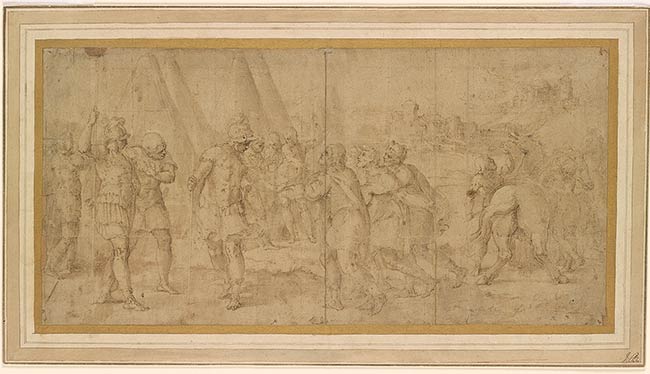

As noted by Anne Varick Lauder, this drawing is one of three studies by Franco for the same composition, which she dates to the late 1540s or 1550s.1 The two related sheets contain figure studies that probably precede the Morgan composition. One of these, in red chalk, is now in the Louvre; the other, a pen-and-wash study, is now in a private American collection and seems to be the earliest of the two.2 Although the precise subject of the composition remains unknown, the costume of the protagonists in the Morgan drawing suggests a scene from Roman history. As Lauder notes, it is possible that the drawings relate to maiolica designs, for which Franco often illustrated scenes from Roman history, or the artist’s painted decorations for the ephemeral decorations honoring the 1548 marriage of Guidobaldo II della Rovere, Duke of Urbino, and Vittoria Farnese.3 Ultimately, she suggests that the drawings were most likely connected to a now-lost mural fresco for a villa in the Marche or a private palace in Venice, painted after Franco’s return to the region, ca. 1552, where he would spend his final decade.4
Franco is known to have decorated several buildings on the Venetian mainland though hardly any evidence of this activity survives. Vasari mentions that while working on frescoes for the Grimani chapel, Venice, Franco also found time to decorate “the villas of certain gentlemen,” though the only documented case concerns Franco’s decorations for the Villa Foscari at Malcontenta di Mira, near Venice, constructed ca. 1558.5 In a lunette in Palazzo Grimani di Ruga Giuffa, Venice, there are stories of Coriolanus. A number of extant drawings by Franco appear to be studies for villa or palace decorations of his second Venetian period. Other related sheets depicting scenes from ancient Roman history are Franco’s, Abduction of Hesione by Hercules, in the National Gallery, Ottawa; An Extensive Landscape with Figures Fishing in a Bay, which appeared on the art market in 2000; and two drawings at Windsor Castle: The Women before Coriolanus and Scene before the Castel Sant’Angelo.6
Footnotes:
- Lauder 2009, 228.
- Louvre, Paris, inv. 4926; Lauder 2009, 226-28, no. 58. For the drawing in a private collection, see Ongpin, in New York and London, 2002, no. 4.
- For Franco’s maiolica designs, see Clifford and Mallet 1976, 386-410.
- Lauder 2009, 228.
- Vasari 1878-85, 6: 586, “lavorato alcune cose a fresco per le ville d’alcuni gentiluomini”.
- National Gallery of Art, Ottawa, inv. 15214; Colnaghi, New York, 4 May-2 June, 2000, no. 5; Windsor Castle, Royal Collection, inv. 990381, 990384.
Watermark: none visible through lining.
Inscribed on verso of mount, "Given me by S.r J~: Thornhill. Oct: 1724; J: B~ N. 134 / 16 1/4 by 8; Lot 51-H".
Thornhill, James, Sir, 1675-1734, former owner.
Richardson, Jonathan, 1665-1745, former owner.
Barnard, John, 1709-1784, former owner.
Murray, Charles Fairfax, 1849-1919, former owner.
Morgan, J. Pierpont (John Pierpont), 1837-1913, former owner.
Morgan, J. P. (John Pierpont), 1867-1943, former owner.
Selected references: Fairfax Murray, 1905-12, 4: no. 72; Ongpin, in New York and London 2002, under no. 4; Lauder 2009, 227, under no. 58, 229, under no. 59.
Collection J. Pierpont Morgan : Drawings by the Old Masters Formed by C. Fairfax Murray. London : Privately printed, 1905-1912, IV, 72, repr.
